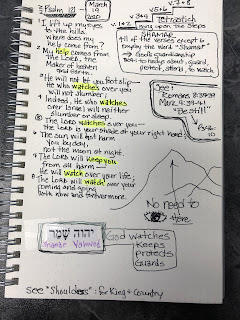Allegory
Galatians 4:21-31
21Tell
me, you who desire to be under the law, do you not listen to the law? 22For
it is written that Abraham had two sons, one by a slave woman and one by a free
woman. 23But the son of the slave was born according to the flesh,
while the son of the free woman was born through promise. 24Now this
may be interpreted allegorically: these women are two covenants. One is from
Mount Sinai, bearing children for slavery; she is Hagar. 25Now Hagar
is Mount Sinai in Arabia; she corresponds to the present Jerusalem, for she is
in slavery with her children. 26But the Jerusalem above is free, and
she is our mother. 27For it is written, “Rejoice, O barren one who
does not bear; break forth and cry aloud, you who are not in labor! For the
children of the desolate one will be more than those of the one who has a
husband.” 28Now you, brothers, like Isaac, are children of promise. 29But
just as at that time he who was born according to the flesh persecuted him who
was born according to the Spirit, so also it is now. 30But what does
the Scripture say? “Cast out the slave woman and her son, for the son of the
slave woman shall not inherit with the son of the free woman.” 31So,
brothers, we are not children of the slave but of the free woman.
Using the
details of Old Testament History, with which his readers would have been very well acquainted, Paul creates an allegory to illustrate his vital point about refraining
from leaning on Jewish tradition to augment the Gospel. This history involves
Abraham, Sarah, and Hagar, along with the two sons born to these three people,
Ishmael and Isaac.
For Paul,
the slave woman and the free woman stand for two covenants. The son born first
to Hagar, Ishmael, is born according to the flesh. His birth was contrived by
Abraham, Sarah, and Hagar. In Paul’s allegory, those who claim the traditions
of Judaism are necessary for salvation are bound to the Law and the Law cannot
save us. The free woman, Sarah, bears a child according to the spirit. Isaac
was born through the work of God, who brought about a miracle on an aged woman and
thus is bound to the Spirit and the freedom of God. This is a vast over
simplification of Paul’s picture, but which would you rather be associated with
in this story? Those of the Law, or those of the Spirit?
The above
words are the short version of what Paul has done with this little bit of
history. Below, I have inserted a rather lengthy bit of The Concordia
Commentary: Galatians, by A.A. Das for those who would like a more in-depth
conversation. For me, this has brought some clarity to a rather unusual
passage.
To “speak allegorically” would refer
to the Genesis text itself whereas to “interpret allegorically” would refer to Paul’s interpretation of the Genesis
text. In other words, if Paul were saying that the Genesis texts are “spoken
allegorically,” then he would be claiming that they should not be taken on
their own terms as referring to actual events. The modern interpreter must
recognize that Paul is not dismissing but rather assuming the factual nature of
the Genesis account. He explains his interpretive approach in 4:25: Hagar “is
aligned with” or “corresponds to” (συστοιχεῖ) the present Jerusalem. The
translation “taken figuratively” in 4:24 (instead of “spoken allegorically”)
helps avoid the mistaken notion that Paul does not take Genesis at face value.
The intensely polemical nature of Paul’s discussion here must be kept in mind
as he shockingly associates Mount Sinai with the children of Hagar. As Paul
responds to the manner in which these texts were interpreted and taught by
others at Galatia, he signals clearly his non-literal approach.
An appreciation of the cultural
context of Paul’s remarks is helpful for interpreting 4:21–31. North and south
Galatia are both located in the ancient land of Anatolia. Central Anatolia was
a melting pot of peoples of diverse origins: Hittite, Persian, Greek, Gallic,
and Roman. The Anatolians in both the north and the south worshiped the
Mountain Mother of the Gods. In the northern lands, for instance, Pessinus
served in effect as a temple state with sacred slaves and a temple hierarchy
ruled by a priest-king, Attis, who was the object of the goddess’ affection.
Overlooking this major center of trade was Mount Dindymus, known to the
inhabitants as “Meter Dindymene,” “the Mother of the Gods.” The inhabitants of
the city were her “children.” The Mother Goddess was also one of the “enforcer
deities” who oversaw the legal system. Laws and property deeds were stored in
the city of Athens, for example, at the temple of the Mother of the Gods. One
group of slaves serving the Mother Goddess were called the “galloi.” They were
young men who, caught up in the frenzy of the orgiastic rituals, castrated
themselves to demonstrate their loyalty and to begin their service to the
Mother Goddess. Susan M. (“Elli”) Elliott, in her doctoral work, called
attention to the numerous parallels between the Mother Goddess cult and Paul’s
letter to the Galatians. In 4:21–31 Paul associates the Law with a mother,
Hagar, as well as with a mountain, Sinai, and this mother has her children as
well. Later in 5:12 Paul mocks circumcision as a sort of galloi-like
mutilation. Paul’s rhetoric against the slave woman Hagar, a.k.a. Mount Sinai,
would be heard by the Galatians within this cultural context. In a stroke of
rhetorical genius, Paul communicates to his Anatolian hearers that the adoption
of the Jewish Law is the equivalent of a return to the harsh bondage and
oppression of their pagan past.
Das,
A. A. ©2014. Galatians. (pp. 486–487,489).
Saint Louis, MO: CPH.



Comments
Post a Comment